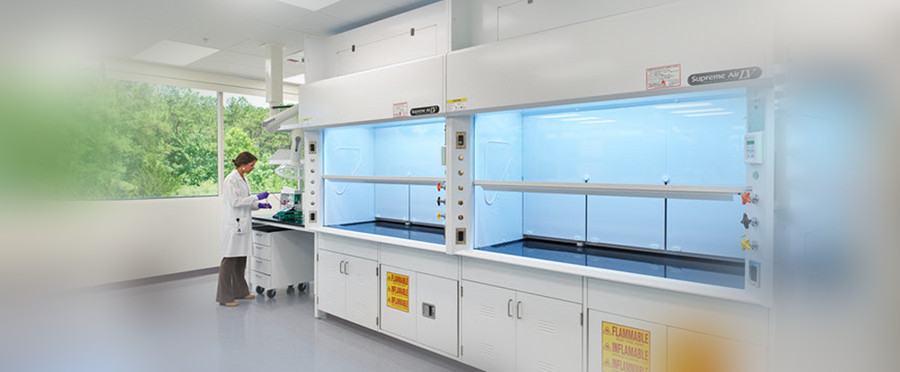Four Technologies That Are Changing Lab Safety
Which of today’s complex exposure control installations will best serve your business objectives while keeping workers safe?
Photography credit: Triggs Photography, LLC
Lab technology is constantly in motion. Every industry is under pressure to continually audit their equipment and make decisions about when and how to install the latest solutions—from robotic packaging systems in the food and beverage industry to artificial intelligence-enabled analytical tools in pharmaceutical research labs.
As these labs become more sophisticated, their safety infrastructure must evolve, too. In many older labs, workers are protected by equipment that was once sufficient but can no longer keep up with modern safety guidelines. Owners of new labs also face a challenge: As they design their workspaces, they need to decide which of today’s complex exposure control installations will best serve their business objectives while keeping workers safe.
These are not simple decisions. How can a lab owner measure the upfront costs of installing new safety technology against the potential for long-term savings? What does a holistic risk assessment look like, and how should lab owners, managers, and operators use it to identify the best-fit safety equipment from what seems like an endless variety of choices?
Whatever your lab’s objective, these insights will help you begin evaluating the latest and most appropriate lab exposure control technology for your situation.
Biological Safety Cabinets
The basic purpose of biological safety cabinets (BSCs), which is to filter and recirculate or exhaust air, hasn’t changed much in 70 years, but the technology that makes this possible certainly has. Today’s BSCs are more sophisticated, diverse, and efficient than ever, which means that well-informed lab owners are able to find and install cabinets that are uniquely suited to their needs.
- A cabinet right-sized for your lab’s unique hazards. Your lab has a specific biosafety level that requires a certain degree of exposure control. Of the many choices available today, experts can help you identify which BSCs are right for your lab.
- A cabinet that reduces cost. Installing an insufficient BSC is hazardous. Installing a BSC that’s more powerful than necessary is hazardous in another way; it can lead to unnecessarily high operational costs. Determine how to take advantage of the latest high-efficiency BSCs so that you get the protection your lab needs without overpaying for more than what’s required.
- A cabinet with a smaller footprint. Assess your lab’s built environment to ensure that you choose the BSC that makes the most efficient use of your available space, and we’ll work with you to ensure proper installation and operation.
- A cabinet that keeps workers safe and comfortable. Modern labs not only help protect workers from the hazards of exposure, but also from the hazards of clocking long hours at a poorly designed workstation. Today’s BSCs mitigate this physical risk by offering ergonomic designs meant to improve working conditions and prevent chronic injury.
Fume Hoods
Traditional ducted fume hood technology is giving way to modern designs that help labs operate safely and more cost-effectively. In the right situation, lab owners can take advantage of these innovations in two important ways:
- A fume hood that reduces lab energy loads. Modern fume hoods feature improved sash designs and streamlined airfoils, which means they can safely evacuate chemicals at a lower face velocity than their traditional predecessors.
- A ductless, recirculating fume hood. Using breakthrough carbon filter technology, modern fume hoods are able to purify and recirculate air internally, reducing a lab’s heating and cooling costs as well as the costs of maintaining an external exhaust fan.
Isolators
Traditional isolator setups were once a necessary barrier to efficiency. Lengthy decontamination and gowning processes meant that nothing could move very quickly, not even after the introduction of gloved interfaces. But today’s isolator technology changes all that. In the right situation, lab managers can greatly reduce cycle times while keeping workers safe by taking advantage of new technology:
- Isolators that use ionized hydrogen peroxide (IHP). By replacing traditional vaporized hydrogen peroxide (VHP) systems, these isolators can decontaminate materials much faster, making efficient, continuous throughput possible.
- Isolators designed for personalized medicine. Highly individual therapies require a completely closed internal environment. Modern isolators make this possible. They use advanced robotics to keep small, compartmentalized batches completely isolated from one another and the surrounding environment, removing even the risk of contamination via a human operator.
Ventilated Enclosures
Robotic installations are quickly rising to prominence in modern lab environments across nearly every industry. Although they require far less safety infrastructure than the human worker, robotics do need an enclosed clean room to ensure safe and consistent sample handling. Today’s ventilated enclosures are designed with this in mind, ensuring only particulate-free air comes in contact with the robotic work surface.
Conclusions
Lab safety is a complex issue that requires close, individual assessment. One lab’s solution may involve the latest and most powerful exposure control technology, while another lab may need nothing more than a slight adjustment in its safety network.
Understanding the right way forward for your own lab’s unique risks and user needs can result in a better working environment for your personnel, higher product integrity for patients, and a much more cost-efficient, productive throughput to improve your company’s bottom line.
For more information, visit www.crbusa.com.
Matt Decker is a licensed architect in Pennsylvania and has 10 years of experience. Decker pays close attention to detail while gathering information in a staged approach, which leads the team to design a safe and successful laboratory. His role, above all else, is to ensure the safety of those who occupy or use a building for scientific discovery. Decker’s foundation in safety requires knowledge of specialized code compliance and fluency in regulatory and industry guidelines specific to laboratories.



